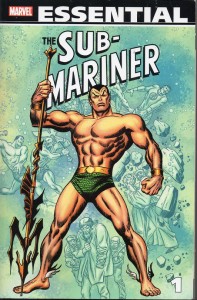Comic Book Review: Essential Sub-Mariner Vol. 1 Edited by Stan Lee
Namor, the Sub-Mariner, first appeared in Marvel Comics #1 in 1939. The son of Captain Robert McKenzie, an icebreaker commander assigned to the Antarctic area, and Princess Fen of Atlantis, Namor possessed hybrid vigor that made him stronger than any ten humans or Atlanteans, the ability to breathe both water and air, and tiny wings on his ankles that allowed him to fly. (Best not to think about that too hard.) Despite his mixed heritage, Namor considered himself an Atlantean first and foremost.
When surface-dwellers’ actions threatened Atlantis, Namor decided to conquer them to put an end to this. By himself. This didn’t go exactly as planned; while individual surface-dwellers were puny (but often decent people) en masse they were extremely dangerous (and hostile.) After a massive battle with the original Human Torch (one of comics’ first crossovers) Namor chose to concentrate his ire on the most evil surface-dwellers, criminals and Nazis. Thus he became superhero comics’ first successful antihero feature.
After the war, superhero comics were on the wane, and Namor stopped being published in 1949, with a brief revival in 1954-55 that did not pan out.
By 1962. however, superheroes were back in force, and Namor reappeared in Fantastic Four #4, when the new Human Torch found him as an amnesiac derelict in the Bowery district of New York City. Exposure to the Torch’s flame and being dunked in the ocean revived many of Namor’s memories, and the Sub-Mariner swam home to Atlantis, only to find it flattened, supposedly by surface-dweller atomic tests. Incensed, Namor once again became an enemy to air-breathing humanity, battling the Fantastic Four and the Avengers (and accidentally helped bring back Captain America.)
Eventually, it was discovered that most of the Atlanteans were still alive, if scattered, and Prince Namor brought them together to build a new Atlantis. He also met Lady Dorma, who would be his romantic interest for some years. This softened Namor’s approach somewhat, and Marvel decided it was time for the Sub-Mariner to get his own solo feature. Which brings us to the volume at hand.
Essentials are the Marvel counterpart to the DC Showcase volumes I’ve reviewed previously, thick volumes of black and white reprints for a reasonable price.
The storyline begins in Daredevil #7, with Namor trying to resolve his dispute with the surface-dwellers through legal means, randomly selecting the law firm of Nelson & Murdock. Sadly, Namor doesn’t really understand the American legal system and has the patience of a cranky two-year-old, so he’s soon on a rampage that Matt Murdock has to contain as Daredevil.. It’s a severe mismatch, as Daredevil is basically a very acrobatic middleweight boxer and Namor can throw down with the Hulk. It’s a pity this one is in black and white, as it’s the first appearance of DD’s red costume.
We then go to Namor’s solo feature, which took up half of Tales to Astonish while the Hulk had the other half (due to a distribution deal with DC Comics, Marvel could only print so many titles a month, and so many of them were timeshares.) We learn that while Prince Namor was in the Big Apple, Warlord Krang seized power in Atlantis. Namor decides on a dangerous quest to get proof of his right to rule, assisted at points by senior citizen Vashti (who is made vizier in gratitude.)
Namor cannot get a moment’s peace. Even after regaining the throne, he must deal with crisis after crisis. If it is not some surface-dwellers accidentally endangering Atlantis, it’s an Atlantean pretender to rulership who wants to overthrow Namor and sit on the throne himself. There are epic clashes with Iron Man and the Hulk, as well as classic villains Puppet Master and the Plunderer.
In 1968, Marvel Comics finally got its own distribution, and it opened up space for the Sub-Mariner to get a full-length book of his own. As a lead-in, there is a plotline in which Namor is banished from Atlantis, and finally decides to pursue the question of just how he came to be an amnesiac derelict for several years. This turns out to have been the work of a powerful villain calling himself Destiny, who also destroyed the first underwater Atlantis. Destiny temporarily defeats Namor, who then spends the first issue of his own title recapping his origin.
And that’s where we leave off. There are some pages of original artwork, a spare cover from a story that was not printed in this volume because it only had one panel of Namor, and Namor’s Who’s Who entry.
This was the era of bombastic Marvel dialogue, as Stan Lee was writing (to a degree) most of the line’s output. This gives us such gems as “Eternal Atlantis! How my very heart leaps at the sight of its undersea beauty! This is the land I was born to rule, and nothing that lives shall ever rob me of my birthright!” There’s also some great art from the likes of Jack Kirby, Gene Colan and Bill Everett (who designed Namor back in the Golden Age.)
Namor’s greatest weakness is not fire, which weakens his powers and saps his health, but his own overweening pride and hair-trigger temper. Time and again, he leaps to conclusions, or reacts violently to minor slights, which leads to unnecessary battles and mutual distrust with the surface-dwellers. Still, he does not wish to kill unnecessarily, and often goes out of his way to spare or save individuals who may not deserve it.
If you don’t mind a hero who consistently makes boneheaded decisions based on losing his temper, this is great stuff, and classic Marvel action.

